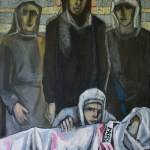
Abed Abdi’s retrospective at the gallery of Umm al – Fahm shows his important contribution to the visual culture of the Palestinians in Israel.
Abed Abdi’s Solo exhibition at the gallery of Umm al – Fahm is a comprehensive retrospective of the artist who for decades was well known to non – Jews in Israel, but almost never exhibited in the mainstream Israeli art scene. In recent years he was exhibited in several exhibitions curated by the curator of the current exhibition, Tal Ben Zvi (including the exhibition “Men in the Sun” at the Herzliya Museum last year).
Abdi has made an important contribution to the visual culture of the Palestinian public in Israel. Since the early ’70s he was the main graphic artist and illustrator in “Al – Ittihad,” the Communists Party daily newspaper in Arabic, and in the literary journal “Al – Jadid “, and created illustrations and book covers of many writers, including Emile Habibi, Salman Natour and Samih al-Qasim.
Abdi also created with Gershon Knispel the monument to commemorate Land Day in Sakhnin, and monuments in Shfaram, Kafr Kana and Kfar Manda, outdoor sculptures, election posters for the Israeli Communist Party, and banners marking political events and various commemoration days.
All of these are presented in the exhibition (source or documentation), that noticeably shows similarity to the works of the Israeli Jewish social realist artists, among them Ruth Schloss, Shimon Tsabar (whom it was interesting to see an exhibition of his relegated works), Moshe Gat, Shraga Weil at certain times and Dani Karavan’s works from the 50’s.
The exhibition also includes paintings created by Abdi, especially since the 80s, that raises affinities to artists as Asad Azi or Ahmad Canaan and shows their impact on each other. Recurrent themes are refugees, exile, Nakba and the proletarian struggle.
The roots of Abdi’s style, and of the rest of Israeli artists of social realism, is rooted in the art of the first half of the last century, especially in Central Europe and the Soviet Union. Beyond Soviet socialist realism, it is particularly influenced by Kathe Kollwitz and Ernst Harlech, German artists who worked within social sensitivity and the hope of changing the world with the rise of communism, socialist Italian artists (for example, Renato Gottoso) and echoes of Mexican art (Diego Rivera, Jose Clemente Orozco and David Alfaro Siqueiros).
The circular motion of expression formulas originating in the West, adopted as Protest art style in places with different cultural heritage, is not unique to Israel. There are many similarities between the art of Communist China, Vietnam (formerly North Vietnam) and in various countries in Africa and the works of Abdi, like women whose large eyes produce sadness, waving fists up high, doves of peace, and imagery from Christian iconography that echoes them again and again.
Refugees ness in Holy Clothes
Abdi was born in 1942 in Haifa. At the beginning of the War of Independence, he fled his home with his mother and brother while his father remained in Haifa. After wandering in refugee camps, the family reunited in 1951. Abdi was active in the Israeli Communist Party at a young age and got acquainted with the artists of Jewish social realism. In 1962 Abdi was the first Arab artist accepted to the Israeli Society of Painters and Sculptors, and in 1964 he went to study art in Dresden, East Germany. There he met Lea Grundig, a Jewish communist artist who fled Germany after a long imprisonment by the Nazis, came to Israel in the early 40’s and lived here until 1948, when she returned to Dresden. She is considered as one of Kollwitz’s significant students, and among the missions she undertook for Communist art where travels to China and Cambodia.
Circuitry of style transitions from Germany before World War II, through East Germany that became the focus of study of arts in the Communist world from the 50’s to the collapse of the regime there, are cultural narrative that can also be thought of in terms of continued European cultural colonialism in the past, that is to say a process that its irony is acute and bitter. Curator Ben Zvi highlights in her article communist ideology as the common denominator that basis the relationship between Grundig and Abdi. But this does not detract from the fact that Abdi, as Communist artists from different parts of the world, has adopted formal and symbolic patterns that have not emerged from this tradition.
Abdi returned to Haifa after spending seven years and for about a decade, until 1982, was a graphical editor and illustrated books and covers of books. Printing arts take central place in his art works, something that shows again the effect of his study in East Germany and the continued long tradition of printmaking, etching and crafting, which were central in Europe. One of the first prizes he won in Israel was The Hermann Struck Etching Prize.
“Refugees in the space” a print on paper from 1968, is one the
Hope for the Return of the Savior

The Extreme ratio between the relative size of the characters and the centered staging recalls in mind a medieval European painting, when the main character is that of a saint. Christian iconography repeats in many of Abdi works, and is interesting precisely because of his professed communist position, that embodies also an attitude that rejects religion. Ben Zvi links between Abdi’s image of the savior to the image of Elijah the prophet or the Al-Khader, in his Muslim name, whom the artist met through his mother tales that appeared in Salman Natour’s story.


Pathos, power and drama are clearly represented in his public works, especially the Monuments in Sakhnin and Shefa Amr.

From the Retrospective raises almost complete unity of a life and art. In this respect, it is not only touching but also represents an essential, less known, period in the history of Israeli Art.
By: Dr Smadar Sheffi, Gallery, “Haaretz”, 08/10/2010
originally appeared here




















